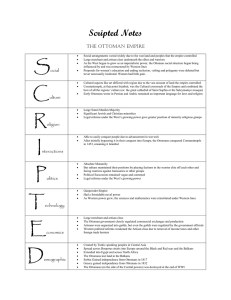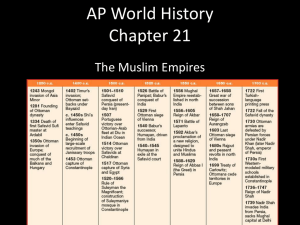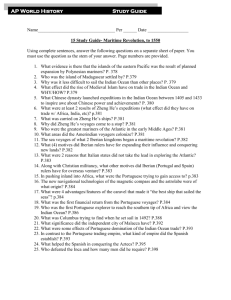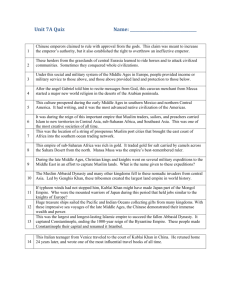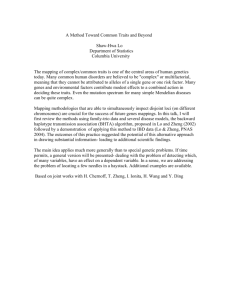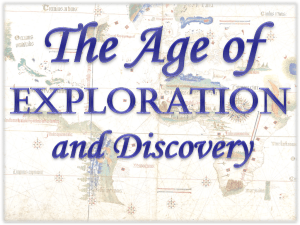15 Century Timelines Episode Five: Century of the Sail (1400-1500)
advertisement
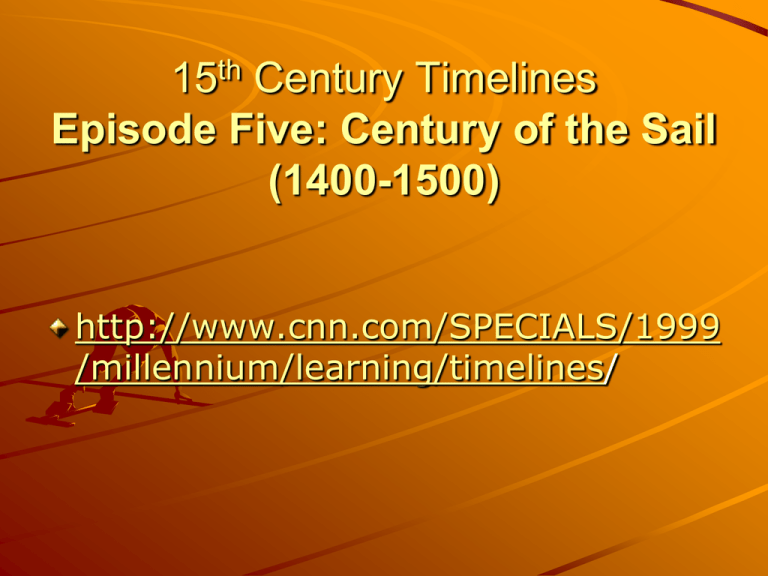
15th Century Timelines Episode Five: Century of the Sail (1400-1500) http://www.cnn.com/SPECIALS/1999 /millennium/learning/timelines/ 15th Century Segments China Italy Central America Turkey Portugal The Larger Fifteenth-Century World Context Events occurring between 1400 to 1500 set the stage for the modern era. In 1428 the Aztecs embarked on a series of successful military campaigns to expand their empire. By the end of the century, their empire stretched from the Gulf of Mexico to the Pacific and as far south as Guatemala. Captives served as sacrificial victims for Aztec religious rituals. 20,000 victims were sacrificed in 1487 during dedication ceremonies for the new temple at Tenochtilan. In Peru, the Inca Empire was established through a series of conquests by two military leaders, beginning in 1438. Inca leaders expanded their empire over a period of 40 years until it stretched more than 2000 miles along the Andes mountain range. Reading, Writing and Travel In 1402, the Koreans perfected moveable metal type. During the years that followed, they steadily devised new fonts and added printing in multiple colors. Their printing processes were adapted by the Chinese. By the end of the century, more people were reading books in China than any other society in the world. Advances in printing technology paralleled other developments. Up to 1411, Ming rulers continued to improve the Grand Canal so grain shipments from the south could be transported north to the capital of Beijing. Silk production increased. The second Ming emperor financed a series of 7 voyages into the Indian Ocean under the command of the Chinese Muslim Zheng He. Government supported expeditions ceased in 1434, a year after the death of the emperor. By the end of the fifteenth century, Ming attention was focused on rebuilding the Great Wall to protect China from northern nomadic invasions. Southeast Asia In Southeast Asia, the Vietnamese revolted against Chinese rule and gained independence in 1428. Increasing levels of Chinese migration into south China pushed the Thai and Burmese into the river valleys of Southeast Asia. In 1431 the Thai defeated the Khmers who had built the elaborate temple palaces of Angkor Wat and Angkor Thom. Buddhism became the dominant religion in the inland regions while inhabitants of the ports and the island kingdoms converted to Islam. The Southeast Asian island kingdoms continued to prosper through their trade in peppercorns and spices. Muslim Advances After the Chinese withdrew from the Indian Ocean, trade was left to the Muslims. Indian textile centers, financed by commercial interests, developed a "putting out" system to distribute cotton and silk to local villagers. Villagers wove silk or cotton into textiles using the spinning wheel, the vertical loom, and block printing. City states along the east coast of Africa traded gold, ivory, and slaves. The Songhai empire, with its famed cities of Jenne and Timbuktu along the Niger river in West Africa, reached its height in approximately 1475. Muslims and other merchants traveled inland from Africa to the islands of Southeast Asia, linking regional markets with the coastal ports. Travel and Trade At the western terminus of the Silk Road, overland caravans changed hands. Representatives of the Italian city states bought Asian products for European markets. Constantinople surrendered to the Ottoman Turks in 1453. From there the Ottomans extended their rule into the Balkans. Serbia was annexed in 1454; Bosnia in 1463; Albania in 1468. By the end of the century, the Ottomans were challenging Hungary. Strategically, the Ottomans realized that if they could control the eastern shores of the Mediterranean and extend their rule into Egypt, they could control overland trade to Asia. Orthodox Christian refugees from Constantinople sought the protection of the Italian city states. As they traveled west, they brought with them the cultural treasures of the Byzantine tradition. The Italian city states continued to prosper through their control of Mediterranean trade. At the western end of the Mediterranean, the Spanish were on the verge of reconquering the last Muslim strongholds. A successful Portuguese attack on the wealthy North African city of Cueta opened a window for the Portuguese to the world beyond. Prince Henry, a younger son of the Portuguese king, established a school of navigation with the hope of outflanking the Muslims by sailing around Africa to the Indian Ocean. During the 1400's Prince Henry's school of navigation developed the caravel, with its rigid hull and multiple masts. He hired expert mapmakers, sea captains, and ship builders. Jewish mapmakers developed accurate portolano maps from information delivered by Portuguese sailors who worked their way along the west African coast. Prince Henry also sought the advice of the Genoise who knew something about the Saharan gold trade. Ship builders added a lateen sail, which was a common feature on ships in the Persian Gulf, and stern post rudders. Ship captains used Muslim astrolabes and Chinese compasses. The Portuguese were ready for exploration. Expeditions By 1500, Europeans had the technological advantage in ship design, mining, metallurgy and gunpowder weapons. Caravels were floating fortresses. These ships could withstand the recoil of heavy cannon fired from the deck and yet were agile and durable in the water. The Portuguese established a lucrative trade in gold and slaves with the west coast of Africa. In 1488 they reached the Cape of Good Hope. By 1498 Vasco da Gama had sailed all the way to India with the help of a Muslim pilot. Columbus used the same navigational technology to sail west from Spain in 1492. These expeditions ushered in an age of European exploration and expansion 15th Century People Christopher Columbus 1451-1506 He failed four times to find a route westward from Europe to the Orient, but the Italian explorer stumbled upon two giant continents rich in raw materials and agricultural products that would change the economy and politics of the world. Christopher Columbus is often criticized -principally for cruelty toward and enslavement of Caribbean natives -- but his delivery on a promise to "discover islands and mainland in the Ocean Sea," however inadvertent, has never been surpassed. Leonardo De Vinci 1452-1519 Renaissance man -- one who knows much and can do more, whose interests are broad and deep, whose zest for inquiry is indefatigable -was born in Vinci, Italy, in 1452 and named Leonardo. As an apprentice he quickly showed painting and sculptural talents. Soon after came projects in engineering, anatomy, architecture, scientific illustration, mapmaking, mathematics, optics. While his finished works -- notably Mona Lisa and The Last Supper -- are few, his copious and disorderly notebooks continue to enthrall us. Regarded as the greatest of great amateurs, this enduring icon of the Renaissance set a mark unequaled by any who came after. Admiral Zheng He 1371 - 1435 In the early decades of the 15th century, the seas off Asia were dominated by the huge Chinese treasure ships of Admiral Zheng He -- each one of them five times as large as a typical European caravel. Zheng, a court eunuch turned diplomat, led seven naval expeditions for Ming Emperor Yongle between 1405 and 1433. Zheng's assignment was to extend China's political sway overseas. His first entourage included 62 ships and 27,800 men; the others were of similar scale, making them the most fantastic naval ventures the world had yet seen. His journeys took him to the east coast of Africa, to Mecca and to India. Zheng always brought back exotic souvenirs as proof of his exploits, including, once, an African giraffe. Joan of Arc 1412-1431 A young peasant who believed she was guided by the voices of saints, Joan of Arc led the French to crucial victories in the Hundred Years War and became a surpassing hero for her countrymen and her fellow Catholics. The teenager who dressed in men's clothing defeated the English at Orleans in 1429; her triumph at Reims not only earned her the nation's adulation but paved the way for the coronation of King Charles VII. On a campaign to free Paris, she was captured, tried for heresy and burned at the stake. Named a saint in 1920, she has been the subject of hundreds of movies, books and plays, including Shaw's Saint Joan. Johan Gutenberg, 1400-1468 The invention of the printing press by Johan Gutenberg (1400-1468) and use of moveable type by the end of the 15th century contributed to the dissemination of printed material and the spread of ideas. Prior to this time, books were hand-lettered usually by monks that limited their availability. Segments – 15th Century CHINA - Summary China began to recover from the plagues and famines of the fourteenth century and turn her energies to maritime expansion. China was best equipped to expand, with technologies far exceeding those of her rivals. Ambitious expeditions left the shores of Asia during the reign of Emperor Yong Le, led by the eunuch Admiral Zheng He. For nearly three decades, Zheng, he set sail with fleets as large as 200 ships and with crews totaling 27,000 men. The ships were some the largest wooden vessels ever constructed, over 400 feet long and 180 feet wide. They were powered by twelve bamboo sails on nine masts and could sail at any angle to the wind. While some claim these expeditions aimed to determine whether there was anything in the world China did not possess, others say the motives of the voyages were unclear. The fleets traveled to points all around the vast Indian Ocean, exchanging gifts with people they met, returning with exotic animals and goods. The expeditions were eventually abandoned; perhaps Confucian scholars decided nothing brought back was of use to China. China entered a period of self-created isolation. ITALY - Summary Western Christendom began to recover from the plague, and European culture experienced a "re-birth" or renaissance. The Renaissance was arguably dependent on sea links between Italy and Atlantic Europe as well as with Constantinople and other major ports around the Mediterranean. Improved and extended maritime connections between Italy, Alexandria, and Cairo ensured the import of exotic spices, clothes, and artifacts from the East. A few private, influential families vied with one another to show off their newfound wealth and stimulated progress in art and architecture. Ambitious new buildings sprang up, works of decorative art were commissioned, cathedrals were adorned with beautiful new frescoes, and artists devised new methods to portray it all on canvas. Italy's strong demand for luxuries and spices in turn inspired the sea voyages of Spain and Portugal. These two countries were on the periphery of Europe and were desperate to gain access to wealth. Trading goods with countries like Italy could provide it. CENTRAL AMERICA - Summary In the Americas, the Aztecs created a vast empire without the use of windpowered crafts or water-based trade; the Aztec civilization was entirely land-bound. The heart of the Aztec empire was the city of Tenochtitlan, a huge, vibrant island in the midst of a swampy lake. From this city the Aztecs controlled thousands of outlying settlements, demanding the tribute which helped keep the main city provisioned and viable. The children of elite citizens were reared to be part of a disciplined warrior class. The warriors maintained the Aztecs' control over conquered peoples. The constant conquest of new peoples was also essential to supply sacrificial victims for offerings to the gods. The Aztec civilization would thrive until the arrival of the Spanish in the next century. TURKEY - Summary The Ottoman people exploited both land and sea-based military technologies to establish a new and vigorous Muslim empire in formerly Christian lands. In 1453, Mehmet the Conqueror led a 100,000-strong army towards Constantinople. Constantinople was one of the richest cities in Christendom, as prosperous as Venice, Florence, or Milan. But Mehmet¹s army outnumbered the inhabitants 7 to 1, and his victory was complete. The conquest changed the fate of Constantinople forever. Mehmet saved the ancient Christian cathedral of Hagia Sophia from destruction, but converted it into a mosque. In addition, he built a vast palace - the Topkapi Sarayi - with kitchens capable of feeding 10,000 people in a day. It was laid out like a nomad's tent, but on a grand scale, and echoed the Ottomans' Turkish style of art and architecture. Other conquests allowed the domain of the Ottomans to grow. Their empire eventually stretched from the Danube in present-day Hungary to the Euphrates in present-day Iraq, straddling the Silk Road. Finally, the Ottomans successfully challenged the Venetian empire at sea, establishing their control over all but the western portion of the Mediterranean. PORTUGAL - Summary The sail changed the fortunes of Portugal and Spain, two sparsely populated maritime nations located on the Iberian peninsula. Merchants were motivated to find a new sea route to the east so they could bypass the many middlemen who imposed taxes and the Ottomans who now had a stranglehold on the important trade routes. The Portuguese edged their way south around the coast of Africa, despite some dangerous sailing waters. Bartolomew Dias rounded the Cape of Good Hope in 1488. But Christopher Columbus was the only one willing to take the ambitious gamble of a direct westerly journey. No one knew what lay to the west of the Iberian peninsula, but many feared the expanse of ocean was the domain of monsters and serpents. By Columbus' calculation, travelling west would eventually bring him to Japan where he would secure exotic goods to sell. The trade winds carried him to San Salvador Island on October 12, 1492. He discovered new territories and brought two very separate parts of the world together for the first time in history. But the real triumph was reserved for Vasco de Gama, who 7 years later actually reached India and the Orient by sea. Expansion and subsequent colonization by the Spanish and Portuguese would forever change the course of history. 15th Century Legacies Moveable metal type encouraged printing, thereby expanding literacy and the diffusion of ideas that stimulated change. Migrations and conquests had an impact on the world's cultural landscape: the Chinese migrated into Southeast Asia; the Thai, Burmese, and Vietnamese established states in Southeast Asia; the Ottoman Turks controlled shipping between the Black Sea and Mediterranean and the land routes from Southwest Asia into the Balkans; the Spanish and Portuguese conquered Iberia; the Aztecs conquered Mexico and parts of Central America; the Inca conquered Peru. India became a leader in the production of cotton textiles using advanced methods of block printing, dying, and weaving. 15th Century Legacies The Portuguese-African slave trade became profitable and established. Expanding zones of maritime trade linked larger regions of the eastern hemisphere. Zheng He, Vasco da Gama, and Columbus established a tradition of state-sponsored exploration that continues into the twentieth century. Europeans won control of the world's shipping lanes through technological changes in ship design, map making, mining, metallurgy, and gunpowder weapons.
